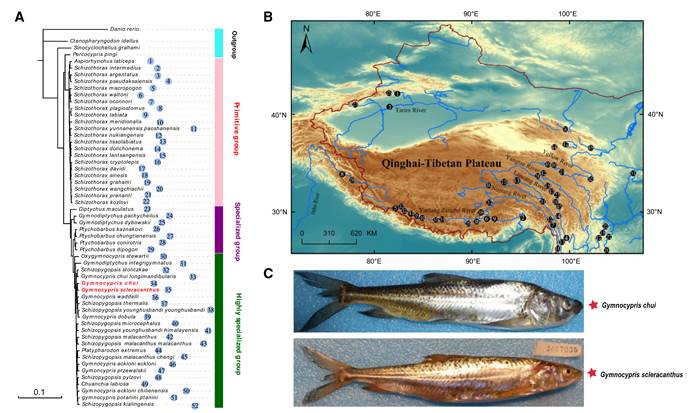
Newsroom
Scientists Reveal Transcriptome-Wide Patterns of Genetic and Expression Variations in Two Sympatric Schizothoracine Fishes in a Tibetan Plateau Glacier Lake
The adaptation of organisms to the environment is a fundamental issue in the study of evolutionary biology and a hotspot in ecological research. However, the controversial scientific question is: Can species living in the same area differentiate into new species during evolution (sympatric speciation)? Although some evidence shows speciation occurring in this way, little is known about the gene expression evolution and the characteristics of population genetics as species diverge.
In order to explore the above mentioned scientific issues, a team of researchers from Institute of Hydrobiology (IHB) of Chinese Academy of Sciences led by Prof. HE Shunping, cooperating with Prof. ZHAO Kai from Northwest Institute of Plateau Biology, studied the genetic and expression variations in two sympatric schizothoracine fishes in a tibetan plateau glacier lake.
Glacier Lake Langcuo, located on the northern of the Yarlung Zangbo River, is at an altitude about 4,300 m. Two sister species of naked carp, Gymnocypris chui and Gymnocypris scleracanthus, are endemic fish that are sympatrically distributed in Lake Langcuo in Tibet.
Researchers compared the transcriptomes of different tissues and found that the expression patterns of intraspecific and interspecific organs are different. At the same time, phylogenetic analyses indicated that the two closely related taxa formed a monophyletic complex. Ordination analysis separated samples by organ rather than by species. Population structure analysis displayed two distinctly divergent clusters of G. chui and G. scleracanthus populations.
By contrast, G. scleracanthus population genetic diversity is higher than that of G. chui. Considerable sites of the two populations were differentiated with a coefficient of FST = 0.25-0.50, implying that a small proportion of loci nevertheless exhibited deep divergence in two comparisons.
Further evolutionary selection pressure and functional enrichment analysis revealed biological differences between the two populations. Differentially expressed genes and positive selection genes were mainly concentrated in pathways related to metabolism, nutrition, and morphological development. Researchers speculated that there was food competition between G. chui and G. scleracanthus in a small plateau glacial lake, and finally they occupied different ecological niches (feeding differences).
This work was supported by grants from the National Natural Science Foundation of China (91731301). Research Paper “Transcriptome-Wide Patterns of the Genetic and Expression Variations in Two Sympatric Schizothoracine Fishes in a Tibetan Plateau Glacier Lake” was published online in the journal “Geneome Biology and Evolution”.

Figure: Phylogenetic tree and geographical distribution (figure by IHB)